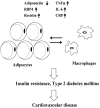The usefulness of circulating adipokine levels for the assessment of obesity-related health problems
- PMID: 18773088
- PMCID: PMC2528071
- DOI: 10.7150/ijms.5.248
The usefulness of circulating adipokine levels for the assessment of obesity-related health problems
Abstract
Because the prevalence of obesity has increased dramatically in recent years, one of the key targets of public health is obesity and its associated pathological conditions. Obesity occurs as a result of white adipose tissue enlargement, caused by adipocyte hyperplasia and/or hypertrophy. Recently, endocrine aspects of adipose tissue have become an active research area and these adipose tissue-derived factors are referred to as adipokines. These adipokines interact with a range of processes in many different organ systems and influence a various systemic phenomena. Therefore, dysregulated production of adipokines has been found to participate in the development of metabolic and vascular diseases related to obesity. The obese state is also known to be associated with increased local and systemic inflammation. Adipokines influence not only systemic insulin resistance and have pathophysiological roles in the metabolic syndrome and cardiovascular disease, but also contribute toward an increase in local and systemic inflammation. Thus, circulating levels of adipokines can be used as high-throughput biomarkers to assess the obesity-related health problems, including low grade inflammation. This review focuses on the usefulness of measuring circulating adipokine levels for the assessment of obesity-related health problems.
Keywords: Adipokine; biomarker; insulin resistance; metabolic syndrome; obesity..
Conflict of interest statement
Conflict of Interest: The authors have declared that no conflict of interest exists.
Figures
Similar articles
-
Should adipokines be considered in the choice of the treatment of obesity-related health problems?Curr Drug Targets. 2010 Jan;11(1):122-35. doi: 10.2174/138945010790030992. Curr Drug Targets. 2010. PMID: 20017725 Review.
-
Identification of adipokine clusters related to parameters of fat mass, insulin sensitivity and inflammation.PLoS One. 2014 Jun 26;9(6):e99785. doi: 10.1371/journal.pone.0099785. eCollection 2014. PLoS One. 2014. PMID: 24968098 Free PMC article.
-
Adipokines, psoriasis, systemic inflammation, and endothelial dysfunction.Int J Dermatol. 2017 Nov;56(11):1103-1118. doi: 10.1111/ijd.13699. Epub 2017 Aug 1. Int J Dermatol. 2017. PMID: 28762474 Review.
-
Translating the biology of adipokines in atherosclerosis and cardiovascular diseases: Gaps and open questions.Nutr Metab Cardiovasc Dis. 2017 May;27(5):379-395. doi: 10.1016/j.numecd.2016.12.005. Epub 2016 Dec 23. Nutr Metab Cardiovasc Dis. 2017. PMID: 28237179 Review.
-
The effect of increasing tertiles of waist circumference on cardio-metabolic risk, adipokines and biomarkers of inflammation and oxidative stress in nascent metabolic syndrome.J Diabetes Complications. 2018 Apr;32(4):379-383. doi: 10.1016/j.jdiacomp.2018.01.008. Epub 2018 Jan 31. J Diabetes Complications. 2018. PMID: 29478813
Cited by
-
Role of nitric oxide (NO) metabolism and inflammatory mediators in childhood obesity.Inflamm Res. 2011 Nov;60(11):1061-70. doi: 10.1007/s00011-011-0367-9. Epub 2011 Aug 27. Inflamm Res. 2011. PMID: 21874355
-
A Study of Short- and Long-term mRNA Levels of the Retn, Iapp, and Drd5 Genes in Obese Mice Induced with High-fat Diet.In Vivo. 2018 Jul-Aug;32(4):813-817. doi: 10.21873/invivo.11312. In Vivo. 2018. PMID: 29936463 Free PMC article.
-
Association of ADIPOQ, leptin, LEPR, and resistin polymorphisms with obesity parameters in Hammam Sousse Sahloul Heart Study.J Clin Lab Anal. 2017 Nov;31(6):e22148. doi: 10.1002/jcla.22148. Epub 2017 Feb 13. J Clin Lab Anal. 2017. PMID: 28195351 Free PMC article.
-
Modulation of the leptin receptor mediates tumor growth and migration of pancreatic cancer cells.PLoS One. 2015 Apr 28;10(4):e0126686. doi: 10.1371/journal.pone.0126686. eCollection 2015. PLoS One. 2015. PMID: 25919692 Free PMC article.
-
Abnormalities in circadian blood pressure variability and endothelial function: pragmatic markers for adverse cardiometabolic profiles in asymptomatic obese adults.Cardiovasc Diabetol. 2010 Sep 24;9:58. doi: 10.1186/1475-2840-9-58. Cardiovasc Diabetol. 2010. PMID: 20868493 Free PMC article.
References
-
- Mello MM, Studdert DM, Brennan TA. Obesity- the new frontier of public health law. N Engl J Med. 2006;354:2601–10. - PubMed
-
- Hossain P, Kawar B, El Nahas M. Obesity and diabetes in the developing world- a growing challenge. N Engl J Med. 2007;356:213–5. - PubMed
-
- Wingard DL, Barrett-Connor E, Criqui MH, Suarez L. Clustering of heart disease risk factors in diabetic compared to nondiabetic adults. Am J Epidemiol. 1983;117:19–26. - PubMed
-
- Reaven GM. Banting lecture 1988. Role of insulin resistance in human disease. Diabetes. 1988;37:1595–607. - PubMed
-
- Ferrannini E, Haffner SM, Mitchell BD, Stern MP. Hyperinsulinemia: the key feature of a cardiovascular and metabolic syndrome. Diabetologia. 1991;34:416–22. - PubMed
Publication types
MeSH terms
Substances
LinkOut - more resources
Full Text Sources
Medical


